ECO mode TESLA MODEL S 2014 (Europe) Owner's Guide
[x] Cancel search | Manufacturer: TESLA, Model Year: 2014, Model line: MODEL S, Model: TESLA MODEL S 2014Pages: 152, PDF Size: 17.5 MB
Page 103 of 152

Tire Care and Maintenance
MAINTENANCE7.5
Improving Tire Mileage
To improve the mileage you get from your tires,
maintain tires at the recommended tire
pressures (see page 7.3), observe speed limits
and advisory speeds, and avoid:
•Pulling away quickly, or hard acceleration.
•Fast turns and heavy braking.
•Potholes and objects in the road.
•Hitting curbs when parking.
•Contaminating tires with fluids that can
cause damage.
Replacing Tires and Wheels
Tires degrade over time due to the effects of
ultraviolet light, extreme temperatures, high
loads, and environmental conditions. It is
recommended that tires are replaced every six
years, or sooner if required.
Wheel rims and tires are matched to suit the
handling characteristics of the vehicle.
Replacement tires must comply with the
original specification. If tires other than those
specified are used, ensure that the load and
speed ratings marked on the tire (see
page 8.10) equal or exceed those of the original
specification.
Ideally, you should replace all four tires at the
same time. If this is not possible, replace the
tires in pairs (both front or both rear). When
replacing tires, always re-balance and check
the alignment of wheels.
For the specification of the original wheels and
tires installed on Model S, see page 8.8.
WARNING: For your safety, use only tires
and wheels that match the original
specification. Tires that do not match the
original specification can affect the operation
of the Tire Pressure Monitoring System (TPMS).
Asymmetric Tires
Model S tires are asymmetric and must be
mounted on the wheel with the correct sidewall
facing outward. The sidewall of the tire is
marked with the word OUTSIDE. When new
tires are installed, make sure that the tires are
correctly mounted on the wheels.
WARNING: Road holding is seriously
impaired if the tires are incorrectly
installed on the wheels.
Winter Tires
In snowy and icy conditions, consider installing
winter tires. Winter tires must be the same size,
brand, construction and tread pattern on all
four wheels. For recommendations on winter
tires, contact Tesla.
WARNING: On dry roads, winter tires
could have less traction than the
originally installed tires.
book.book Page 5 Friday, July 19, 2013 12:53 PM
Page 104 of 152
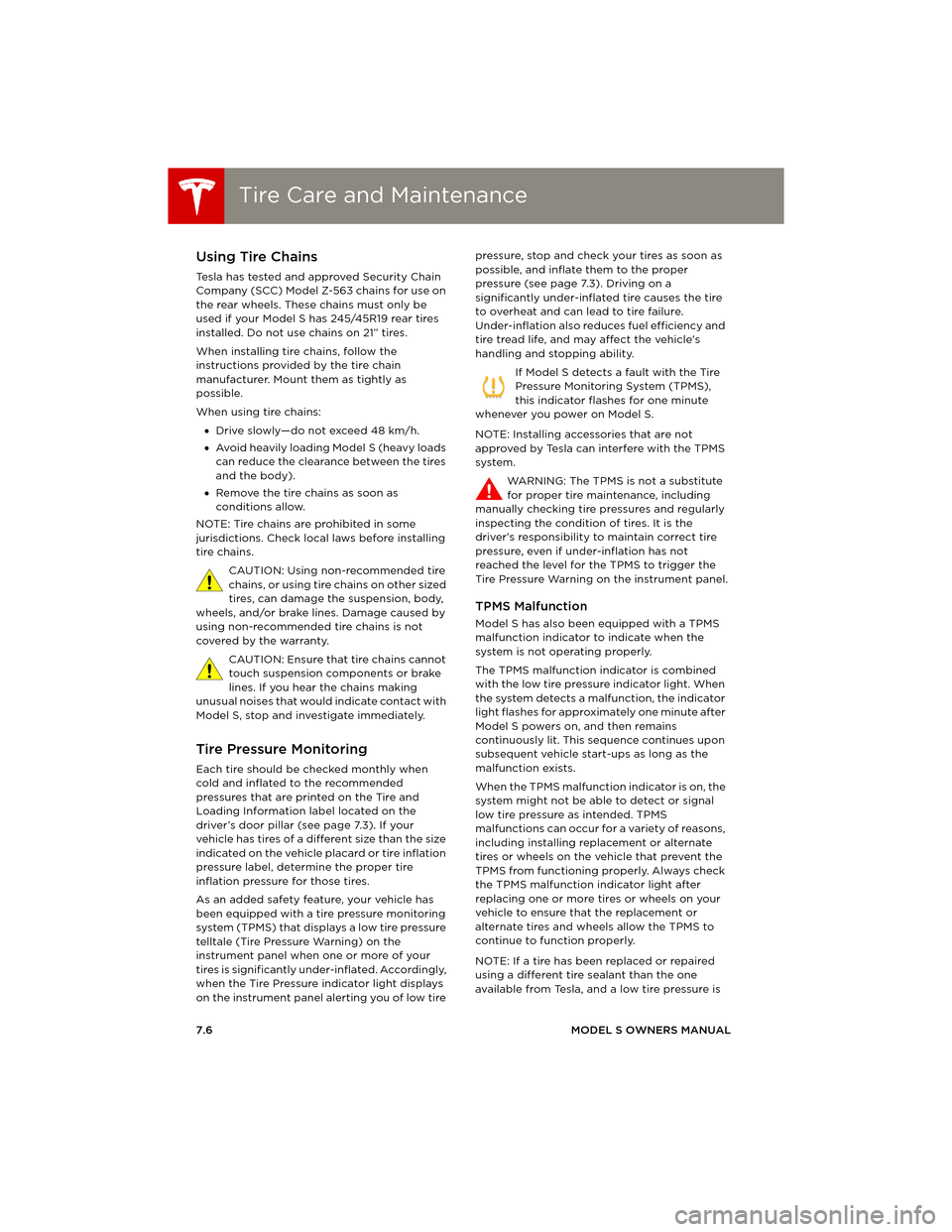
Tire Care and MaintenanceTire Care and Maintenance
7.6MODEL S OWNERS MANUAL
Using Tire Chains
Tesla has tested and approved Security Chain
Company (SCC) Model Z-563 chains for use on
the rear wheels. These chains must only be
used if your Model S has 245/45R19 rear tires
installed. Do not use chains on 21” tires.
When installing tire chains, follow the
instructions provided by the tire chain
manufacturer. Mount them as tightly as
possible.
When using tire chains:
•Drive slowly—do not exceed 48 km/h.
•Avoid heavily loading Model S (heavy loads
can reduce the clearance between the tires
and the body).
•Remove the tire chains as soon as
conditions allow.
NOTE: Tire chains are prohibited in some
jurisdictions. Check local laws before installing
tire chains.
CAUTION: Using non-recommended tire
chains, or using tire chains on other sized
tires, can damage the suspension, body,
wheels, and/or brake lines. Damage caused by
using non-recommended tire chains is not
covered by the warranty.
CAUTION: Ensure that tire chains cannot
touch suspension components or brake
lines. If you hear the chains making
unusual noises that would indicate contact with
Model S, stop and investigate immediately.
Tire Pressure Monitoring
Each tire should be checked monthly when
cold and inflated to the recommended
pressures that are printed on the Tire and
Loading Information label located on the
driver’s door pillar (see page 7.3). If your
vehicle has tires of a different size than the size
indicated on the vehicle placard or tire inflation
pressure label, determine the proper tire
inflation pressure for those tires.
As an added safety feature, your vehicle has
been equipped with a tire pressure monitoring
system (TPMS) that displays a low tire pressure
telltale (Tire Pressure Warning) on the
instrument panel when one or more of your
tires is significantly under-inflated. Accordingly,
when the Tire Pressure indicator light displays
on the instrument panel alerting you of low tire pressure, stop and check your tires as soon as
possible, and inflate them to the proper
pressure (see page 7.3). Driving on a
significantly under-inflated tire causes the tire
to overheat and can lead to tire failure.
Under-inflation also reduces fuel efficiency and
tire tread life, and may affect the vehicle's
handling and stopping ability.
If Model S detects a fault with the Tire
Pressure Monitoring System (TPMS),
this indicator flashes for one minute
whenever you power on Model S.
NOTE: Installing accessories that are not
approved by Tesla can interfere with the TPMS
system.
WARNING: The TPMS is not a substitute
for proper tire maintenance, including
manually checking tire pressures and regularly
inspecting the condition of tires. It is the
driver's responsibility to maintain correct tire
pressure, even if under-inflation has not
reached the level for the TPMS to trigger the
Tire Pressure Warning on the instrument panel.
TPMS Malfunction
Model S has also been equipped with a TPMS
malfunction indicator to indicate when the
system is not operating properly.
The TPMS malfunction indicator is combined
with the low tire pressure indicator light. When
the system detects a malfunction, the indicator
light flashes for approximately one minute after
Model S powers on, and then remains
continuously lit. This sequence continues upon
subsequent vehicle start-ups as long as the
malfunction exists.
When the TPMS malfunction indicator is on, the
system might not be able to detect or signal
low tire pressure as intended. TPMS
malfunctions can occur for a variety of reasons,
including installing replacement or alternate
tires or wheels on the vehicle that prevent the
TPMS from functioning properly. Always check
the TPMS malfunction indicator light after
replacing one or more tires or wheels on your
vehicle to ensure that the replacement or
alternate tires and wheels allow the TPMS to
continue to function properly.
NOTE: If a tire has been replaced or repaired
using a different tire sealant than the one
available from Tesla, and a low tire pressure is
book.book Page 6 Friday, July 19, 2013 12:53 PM
Page 107 of 152
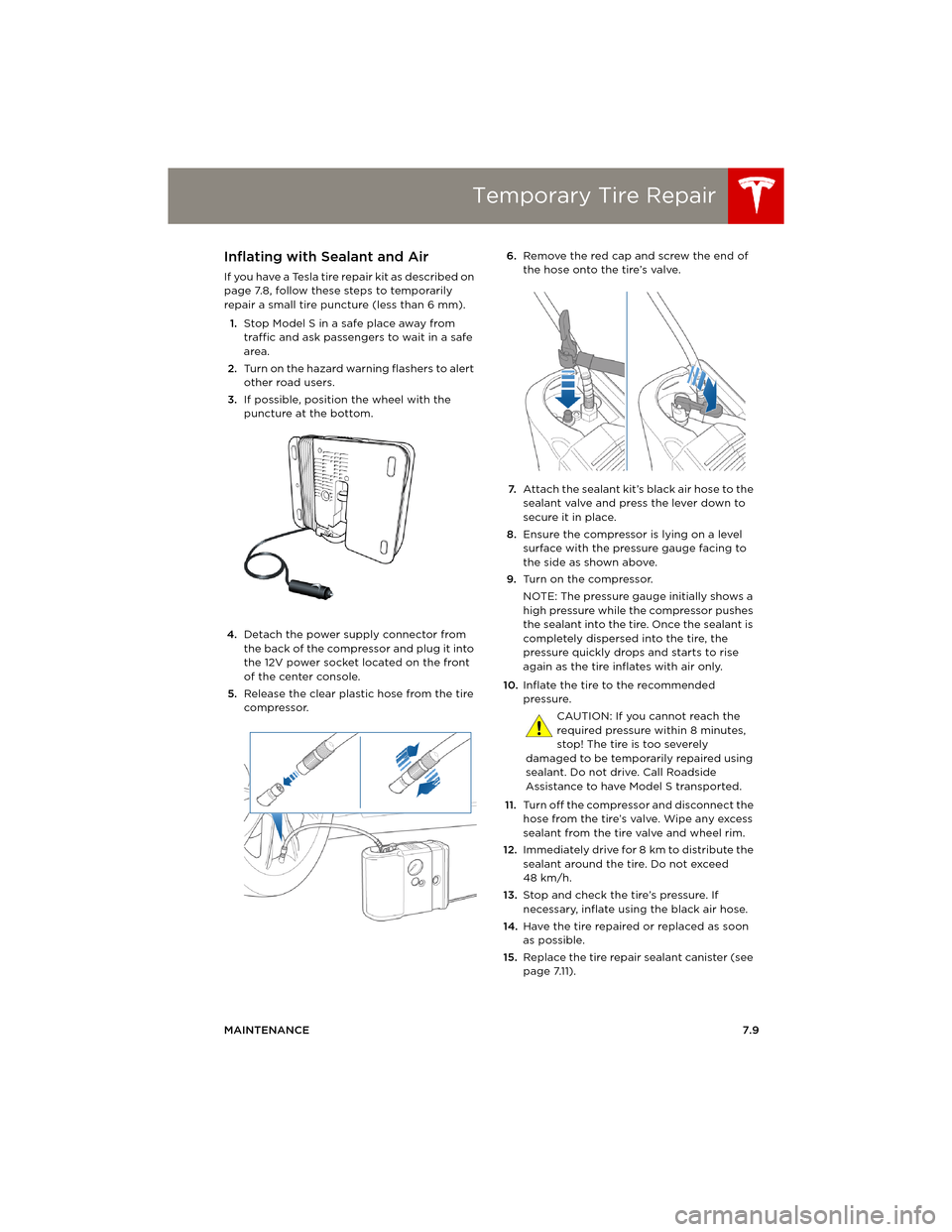
Temporary Tire Repair
MAINTENANCE7.9
Inflating with Sealant and Air
If you have a Tesla tire repair kit as described on
page 7.8, follow these steps to temporarily
repair a small tire puncture (less than 6 mm).
1.Stop Model S in a safe place away from
traffic and ask passengers to wait in a safe
area.
2.Turn on the hazard warning flashers to alert
other road users.
3.If possible, position the wheel with the
puncture at the bottom.
4.Detach the power supply connector from
the back of the compressor and plug it into
the 12V power socket located on the front
of the center console.
5.Release the clear plastic hose from the tire
compressor.6.Remove the red cap and screw the end of
the hose onto the tire’s valve.
7.Attach the sealant kit’s black air hose to the
sealant valve and press the lever down to
secure it in place.
8.Ensure the compressor is lying on a level
surface with the pressure gauge facing to
the side as shown above.
9.Tu r n o n t h e c o m p r e s s o r.
NOTE: The pressure gauge initially shows a
high pressure while the compressor pushes
the sealant into the tire. Once the sealant is
completely dispersed into the tire, the
pressure quickly drops and starts to rise
again as the tire inflates with air only.
10.Inflate the tire to the recommended
pressure.
CAUTION: If you cannot reach the
required pressure within 8 minutes,
stop! The tire is too severely
damaged to be temporarily repaired using
sealant. Do not drive. Call Roadside
Assistance to have Model S transported.
11.Turn off the compressor and disconnect the
hose from the tire’s valve. Wipe any excess
sealant from the tire valve and wheel rim.
12.Immediately drive for 8 km to distribute the
sealant around the tire. Do not exceed
48 km/h.
13.Stop and check the tire’s pressure. If
necessary, inflate using the black air hose.
14.Have the tire repaired or replaced as soon
as possible.
15.Replace the tire repair sealant canister (see
page 7.11).
book.book Page 9 Friday, July 19, 2013 12:53 PM
Page 112 of 152
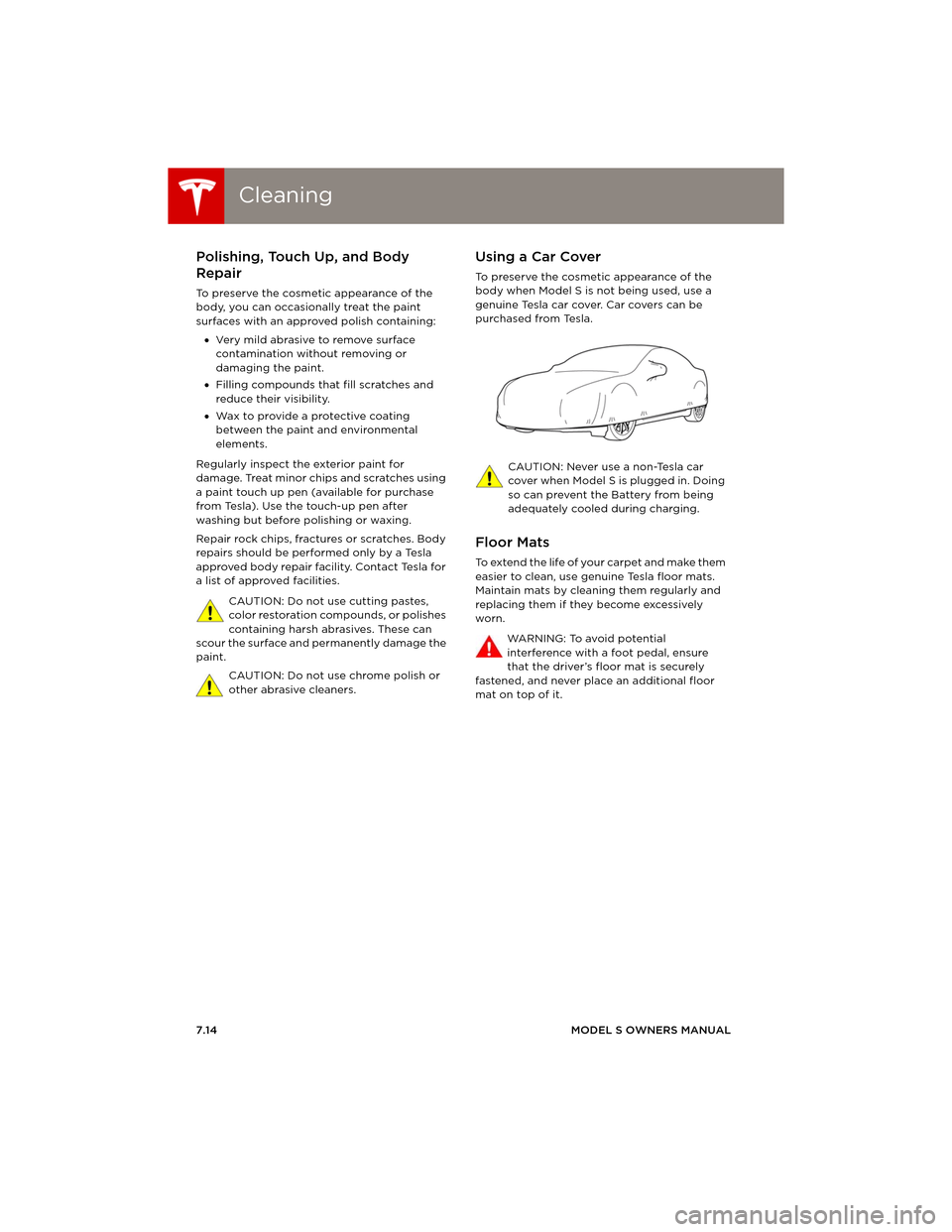
CleaningCleaning
7.14MODEL S OWNERS MANUAL
Polishing, Touch Up, and Body
Repair
To preserve the cosmetic appearance of the
body, you can occasionally treat the paint
surfaces with an approved polish containing:
•Very mild abrasive to remove surface
contamination without removing or
damaging the paint.
•Filling compounds that fill scratches and
reduce their visibility.
•Wax to provide a protective coating
between the paint and environmental
elements.
Regularly inspect the exterior paint for
damage. Treat minor chips and scratches using
a paint touch up pen (available for purchase
from Tesla). Use the touch-up pen after
washing but before polishing or waxing.
Repair rock chips, fractures or scratches. Body
repairs should be performed only by a Tesla
approved body repair facility. Contact Tesla for
a list of approved facilities.
CAUTION: Do not use cutting pastes,
color restoration compounds, or polishes
containing harsh abrasives. These can
scour the surface and permanently damage the
paint.
CAUTION: Do not use chrome polish or
other abrasive cleaners.
Using a Car Cover
To preserve the cosmetic appearance of the
body when Model S is not being used, use a
genuine Tesla car cover. Car covers can be
purchased from Tesla.
CAUTION: Never use a non-Tesla car
cover when Model S is plugged in. Doing
so can prevent the Battery from being
adequately cooled during charging.
Floor Mats
To e x t e n d t h e l i f e o f y o u r c a r p e t a n d m a k e t h e m
easier to clean, use genuine Tesla floor mats.
Maintain mats by cleaning them regularly and
replacing them if they become excessively
worn.
WARNING: To avoid potential
interference with a foot pedal, ensure
that the driver’s floor mat is securely
fastened, and never place an additional floor
mat on top of it.
maintenance.fm Page 14 Thursday, July 25, 2013 12:49 PM
Page 113 of 152
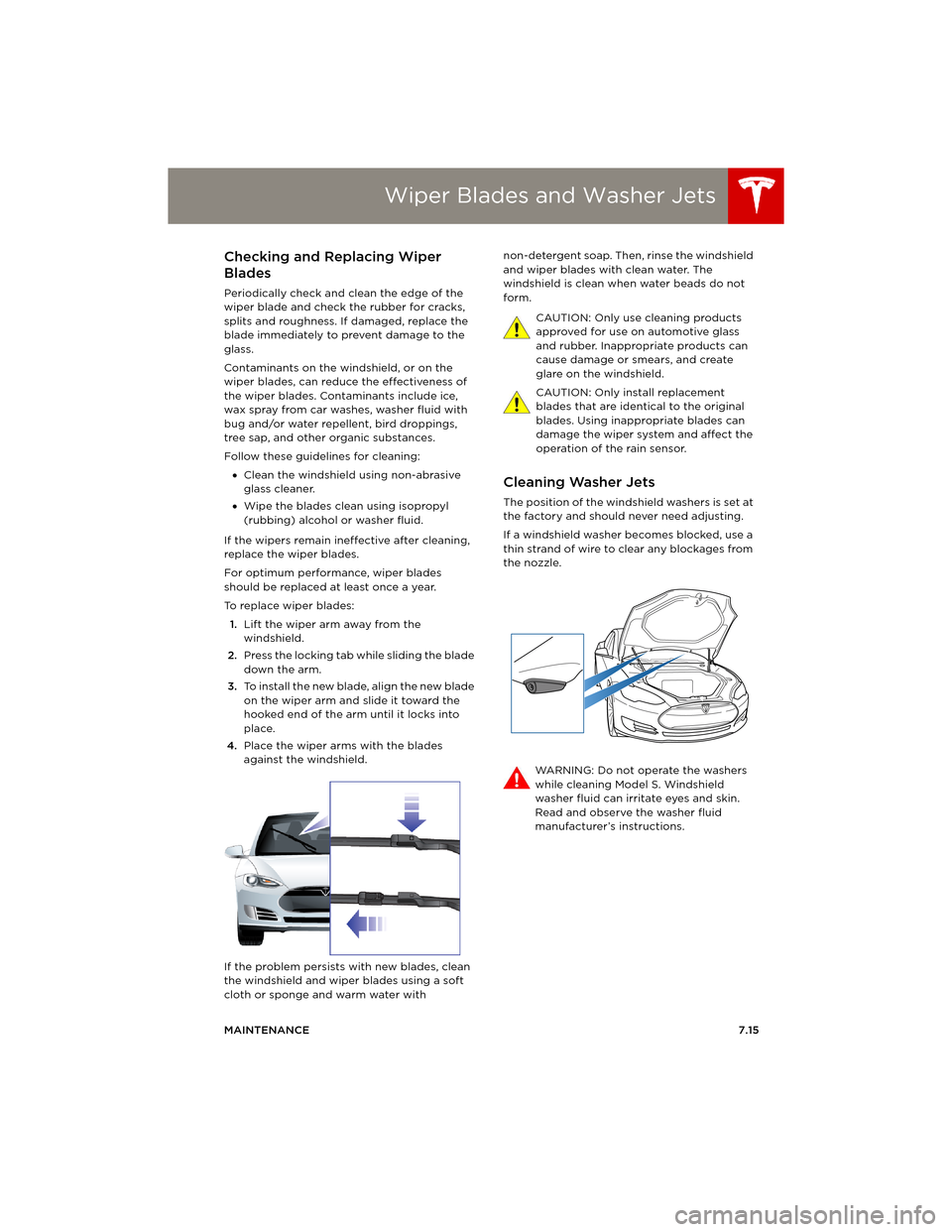
Wiper Blades and Washer Jets
MAINTENANCE7.15
Wiper Blades and Washer JetsChecking and Replacing Wiper
Blades
Periodically check and clean the edge of the
wiper blade and check the rubber for cracks,
splits and roughness. If damaged, replace the
blade immediately to prevent damage to the
glass.
Contaminants on the windshield, or on the
wiper blades, can reduce the effectiveness of
the wiper blades. Contaminants include ice,
wax spray from car washes, washer fluid with
bug and/or water repellent, bird droppings,
tree sap, and other organic substances.
Follow these guidelines for cleaning:
•Clean the windshield using non-abrasive
glass cleaner.
•Wipe the blades clean using isopropyl
(rubbing) alcohol or washer fluid.
If the wipers remain ineffective after cleaning,
replace the wiper blades.
For optimum performance, wiper blades
should be replaced at least once a year.
To replace wiper blades:
1.Lift the wiper arm away from the
windshield.
2.Press the locking tab while sliding the blade
down the arm.
3.To install the new blade, align the new blade
on the wiper arm and slide it toward the
hooked end of the arm until it locks into
place.
4.Place the wiper arms with the blades
against the windshield.
If the problem persists with new blades, clean
the windshield and wiper blades using a soft
cloth or sponge and warm water with non-detergent soap. Then, rinse the windshield
and wiper blades with clean water. The
windshield is clean when water beads do not
form.
CAUTION: Only use cleaning products
approved for use on automotive glass
and rubber. Inappropriate products can
cause damage or smears, and create
glare on the windshield.
CAUTION: Only install replacement
blades that are identical to the original
blades. Using inappropriate blades can
damage the wiper system and affect the
operation of the rain sensor.
Cleaning Washer Jets
The position of the windshield washers is set at
the factory and should never need adjusting.
If a windshield washer becomes blocked, use a
thin strand of wire to clear any blockages from
the nozzle.
WARNING: Do not operate the washers
while cleaning Model S. Windshield
washer fluid can irritate eyes and skin.
Read and observe the washer fluid
manufacturer’s instructions.
book.book Page 15 Friday, July 19, 2013 12:53 PM
Page 114 of 152
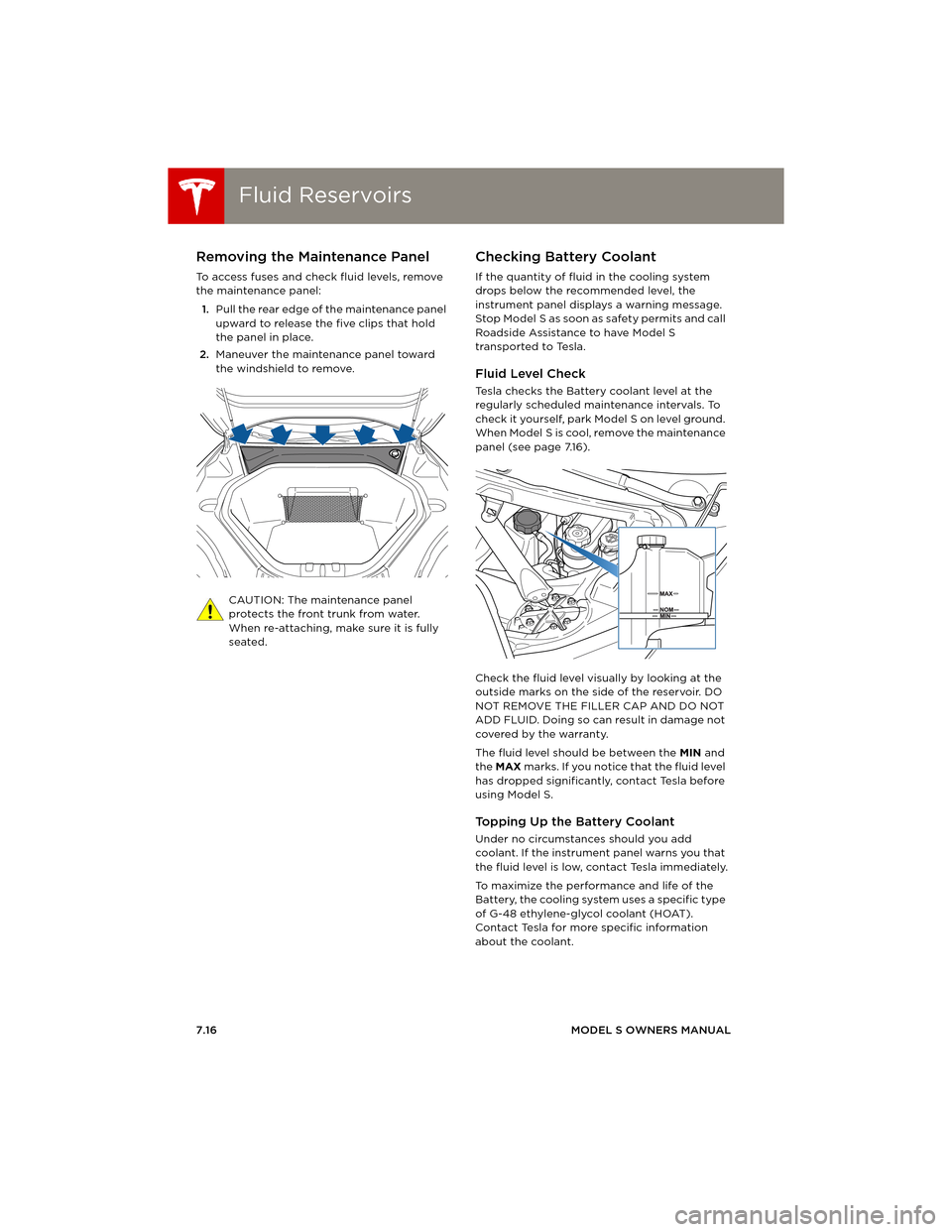
Fluid ReservoirsFluid Reservoirs
7.16MODEL S OWNERS MANUAL
Fluid ReservoirsRemoving the Maintenance Panel
To access fuses and check fluid levels, remove
the maintenance panel:
1.Pull the rear edge of the maintenance panel
upward to release the five clips that hold
the panel in place.
2.Maneuver the maintenance panel toward
the windshield to remove.
CAUTION: The maintenance panel
protects the front trunk from water.
When re-attaching, make sure it is fully
seated.
Checking Battery Coolant
If the quantity of fluid in the cooling system
drops below the recommended level, the
instrument panel displays a warning message.
Stop Model S as soon as safety permits and call
Roadside Assistance to have Model S
transported to Tesla.
Fluid Level Check
Tesla checks the Battery coolant level at the
regularly scheduled maintenance intervals. To
check it yourself, park Model S on level ground.
When Model S is cool, remove the maintenance
panel (see page 7.16).
Check the fluid level visually by looking at the
outside marks on the side of the reservoir. DO
NOT REMOVE THE FILLER CAP AND DO NOT
ADD FLUID. Doing so can result in damage not
covered by the warranty.
The fluid level should be between the MIN and
the MAX marks. If you notice that the fluid level
has dropped significantly, contact Tesla before
using Model S.
To p p i n g U p t h e B a t t e r y C o o l a n t
Under no circumstances should you add
coolant. If the instrument panel warns you that
the fluid level is low, contact Tesla immediately.
To maximize the performance and life of the
Battery, the cooling system uses a specific type
of G-48 ethylene-glycol coolant (HOAT).
Contact Tesla for more specific information
about the coolant.
book.book Page 16 Friday, July 19, 2013 12:53 PM
Page 115 of 152
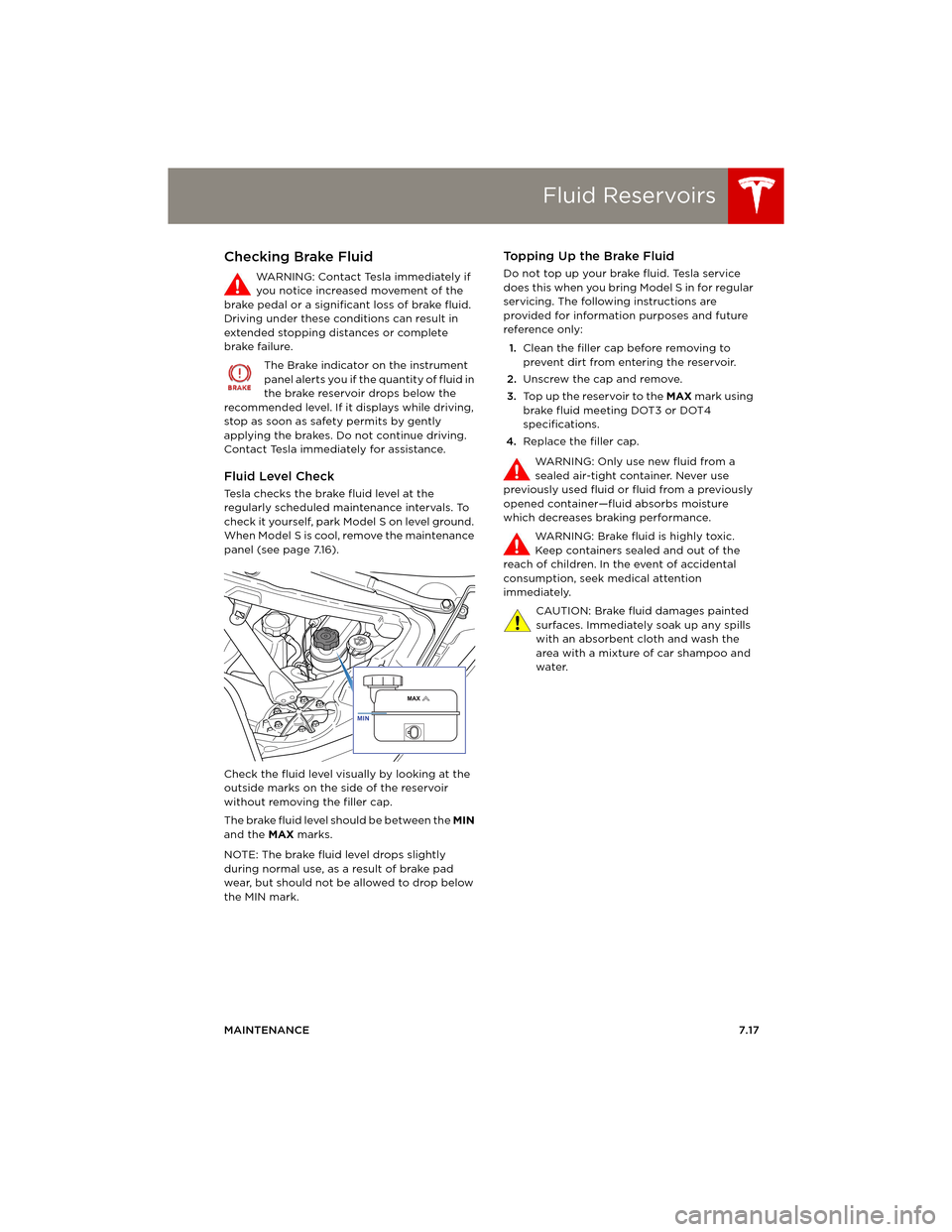
Fluid Reservoirs
MAINTENANCE7.17
Checking Brake Fluid
WARNING: Contact Tesla immediately if
you notice increased movement of the
brake pedal or a significant loss of brake fluid.
Driving under these conditions can result in
extended stopping distances or complete
brake failure.
The Brake indicator on the instrument
panel alerts you if the quantity of fluid in
the brake reservoir drops below the
recommended level. If it displays while driving,
stop as soon as safety permits by gently
applying the brakes. Do not continue driving.
Contact Tesla immediately for assistance.
Fluid Level Check
Tesla checks the brake fluid level at the
regularly scheduled maintenance intervals. To
check it yourself, park Model S on level ground.
When Model S is cool, remove the maintenance
panel (see page 7.16).
Check the fluid level visually by looking at the
outside marks on the side of the reservoir
without removing the filler cap.
The brake fluid level should be between the MIN
and the MAX marks.
NOTE: The brake fluid level drops slightly
during normal use, as a result of brake pad
wear, but should not be allowed to drop below
the MIN mark.
To p p i n g U p t h e B r a k e F l u i d
Do not top up your brake fluid. Tesla service
does this when you bring Model S in for regular
servicing. The following instructions are
provided for information purposes and future
reference only:
1.Clean the filler cap before removing to
prevent dirt from entering the reservoir.
2.Unscrew the cap and remove.
3.Top up the reservoir to the MAX mark using
brake fluid meeting DOT3 or DOT4
specifications.
4.Replace the filler cap.
WARNING: Only use new fluid from a
sealed air-tight container. Never use
previously used fluid or fluid from a previously
opened container—fluid absorbs moisture
which decreases braking performance.
WARNING: Brake fluid is highly toxic.
Keep containers sealed and out of the
reach of children. In the event of accidental
consumption, seek medical attention
immediately.
CAUTION: Brake fluid damages painted
surfaces. Immediately soak up any spills
with an absorbent cloth and wash the
area with a mixture of car shampoo and
water.
book.book Page 17 Friday, July 19, 2013 12:53 PM
Page 125 of 152
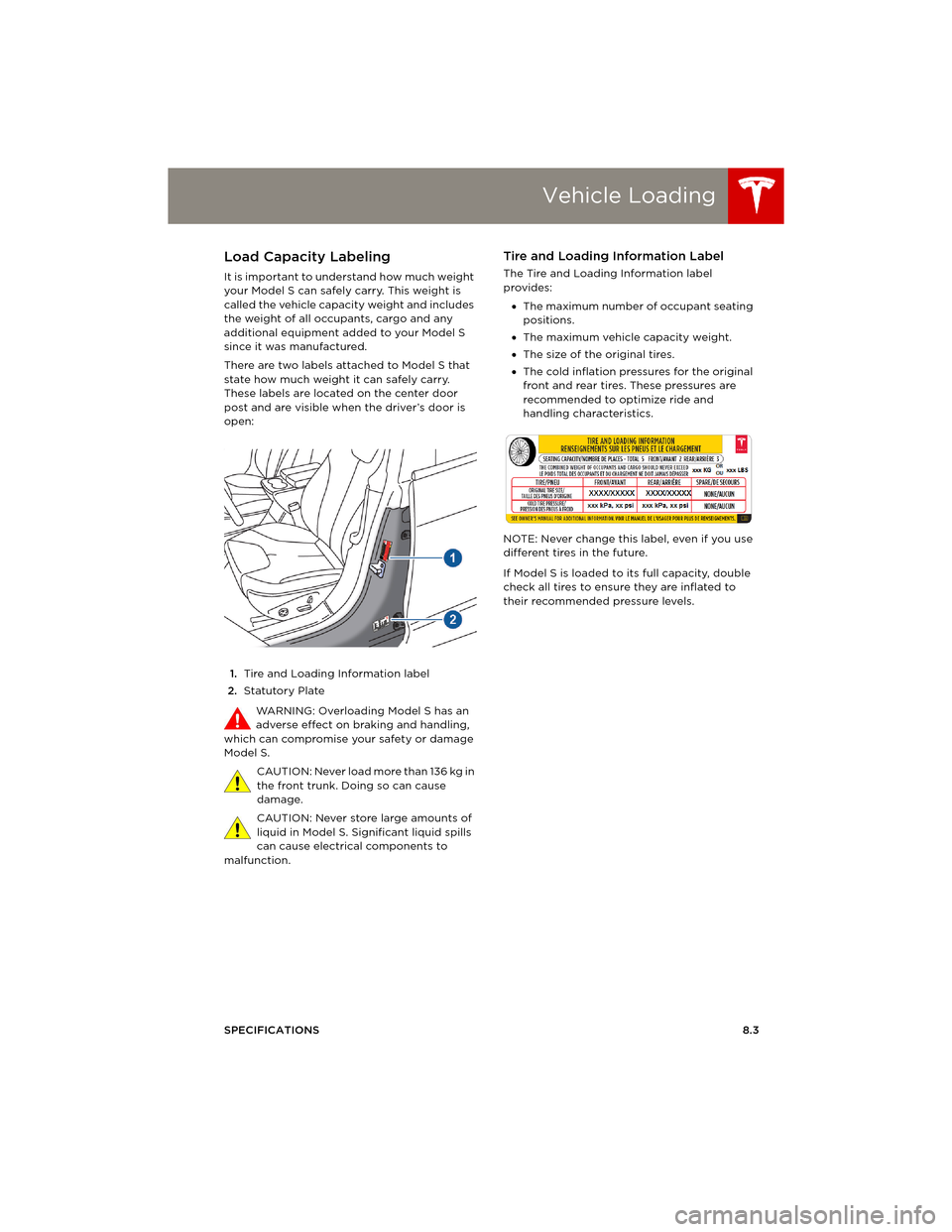
Vehicle Loading
SPECIFICATIONS8.3
Ve h i c l e L o a d i n gLoad Capacity Labeling
It is important to understand how much weight
your Model S can safely carry. This weight is
called the vehicle capacity weight and includes
the weight of all occupants, cargo and any
additional equipment added to your Model S
since it was manufactured.
There are two labels attached to Model S that
state how much weight it can safely carry.
These labels are located on the center door
post and are visible when the driver’s door is
open:
1.Tire and Loading Information label
2.Statutory Plate
WARNING: Overloading Model S has an
adverse effect on braking and handling,
which can compromise your safety or damage
Model S.
C A U T I O N : N e v e r l o a d m o r e t h a n 1 3 6 k g i n
the front trunk. Doing so can cause
damage.
CAUTION: Never store large amounts of
liquid in Model S. Significant liquid spills
can cause electrical components to
malfunction.
Tire and Loading Information Label
The Tire and Loading Information label
provides:
•The maximum number of occupant seating
positions.
•The maximum vehicle capacity weight.
•The size of the original tires.
•The cold inflation pressures for the original
front and rear tires. These pressures are
recommended to optimize ride and
handling characteristics.
NOTE: Never change this label, even if you use
different tires in the future.
If Model S is loaded to its full capacity, double
check all tires to ensure they are inflated to
their recommended pressure levels.
book.book Page 3 Friday, July 19, 2013 12:53 PM
Page 136 of 152
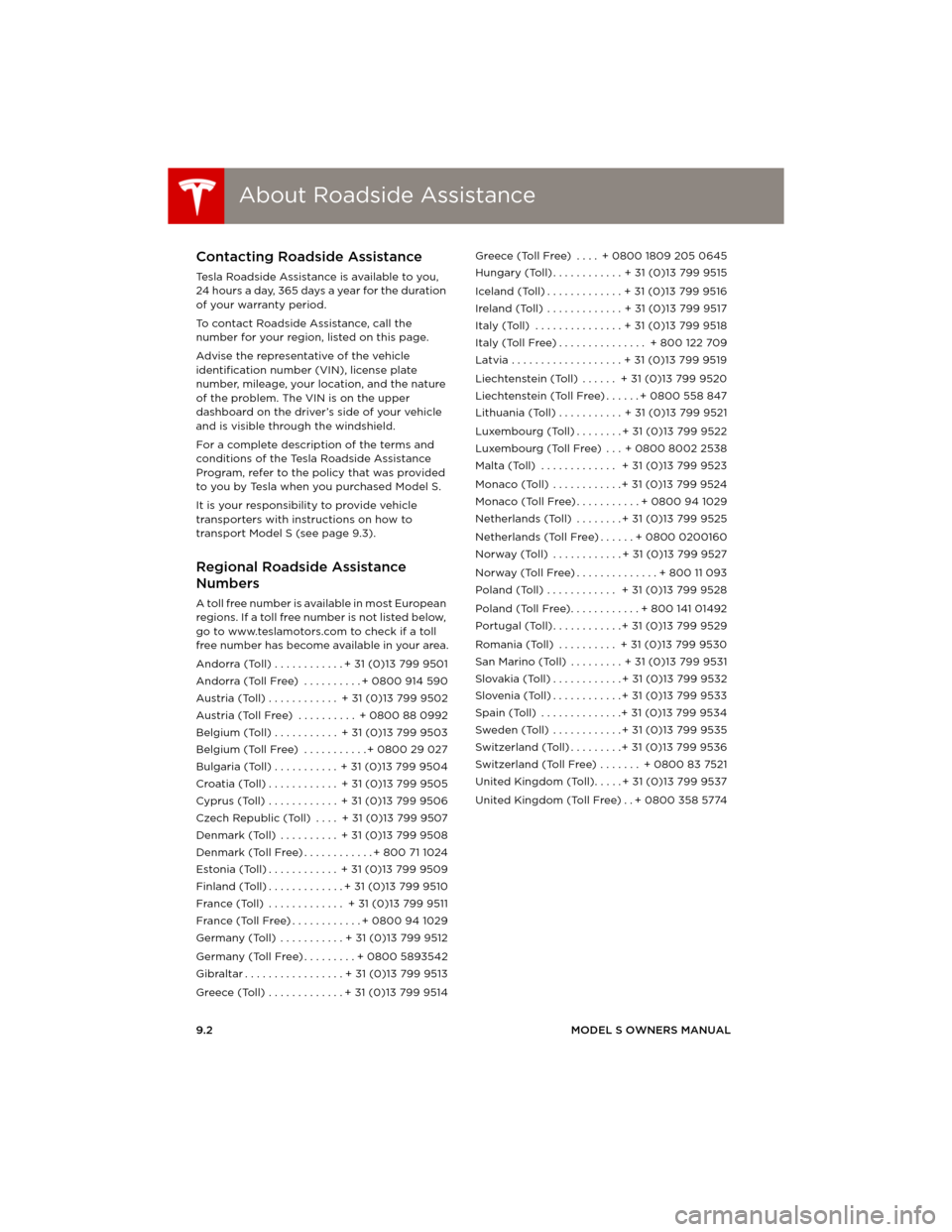
About Roadside AssistanceAbout Roadside Assistance
9.2MODEL S OWNERS MANUAL
ROADSIDE ASSISTANCE
About Roadside AssistanceContacting Roadside Assistance
Tesla Roadside Assistance is available to you,
24 hours a day, 365 days a year for the duration
of your warranty period.
To contact Roadside Assistance, call the
number for your region, listed on this page.
Advise the representative of the vehicle
identification number (VIN), license plate
number, mileage, your location, and the nature
of the problem. The VIN is on the upper
dashboard on the driver’s side of your vehicle
and is visible through the windshield.
For a complete description of the terms and
conditions of the Tesla Roadside Assistance
Program, refer to the policy that was provided
to you by Tesla when you purchased Model S.
It is your responsibility to provide vehicle
transporters with instructions on how to
transport Model S (see page 9.3).
Regional Roadside Assistance
Numbers
A toll free number is available in most European
regions. If a toll free number is not listed below,
go to www.teslamotors.com to check if a toll
free number has become available in your area.
Andorra (Toll) . . . . . . . . . . . . + 31 (0)13 799 9501
Andorra (Toll Free) . . . . . . . . . . + 0800 914 590
Austria (Toll) . . . . . . . . . . . . + 31 (0)13 799 9502
Austria (Toll Free) . . . . . . . . . . + 0800 88 0992
Belgium (Toll) . . . . . . . . . . . + 31 (0)13 799 9503
Belgium (Toll Free) . . . . . . . . . . . + 0800 29 027
Bulgaria (Toll) . . . . . . . . . . . + 31 (0)13 799 9504
Croatia (Toll) . . . . . . . . . . . . + 31 (0)13 799 9505
Cyprus (Toll) . . . . . . . . . . . . + 31 (0)13 799 9506
Czech Republic (Toll) . . . . + 31 (0)13 799 9507
Denmark (Toll) . . . . . . . . . . + 31 (0)13 799 9508
Denmark (Toll Free) . . . . . . . . . . . . + 800 71 1024
Estonia (Toll) . . . . . . . . . . . . + 31 (0)13 799 9509
Finland (Toll) . . . . . . . . . . . . . + 31 (0)13 799 9510
France (Toll) . . . . . . . . . . . . . + 31 (0)13 799 9511
France (Toll Free) . . . . . . . . . . . . + 0800 94 1029
Germany (Toll) . . . . . . . . . . . + 31 (0)13 799 9512
Germany (Toll Free) . . . . . . . . . + 0800 5893542
Gibraltar . . . . . . . . . . . . . . . . . + 31 (0)13 799 9513
Greece (Toll) . . . . . . . . . . . . . + 31 (0)13 799 9514Greece (Toll Free) . . . . + 0800 1809 205 0645
Hungary (Toll) . . . . . . . . . . . . + 31 (0)13 799 9515
Iceland (Toll) . . . . . . . . . . . . . + 31 (0)13 799 9516
Ireland (Toll) . . . . . . . . . . . . . + 31 (0)13 799 9517
Italy (Toll) . . . . . . . . . . . . . . . + 31 (0)13 799 9518
Italy (Toll Free) . . . . . . . . . . . . . . . + 800 122 709
Latvia . . . . . . . . . . . . . . . . . . . + 31 (0)13 799 9519
Liechtenstein (Toll) . . . . . . + 31 (0)13 799 9520
Liechtenstein (Toll Free) . . . . . . + 0800 558 847
Lithuania (Toll) . . . . . . . . . . . + 31 (0)13 799 9521
Luxembourg (Toll) . . . . . . . . + 31 (0)13 799 9522
Luxembourg (Toll Free) . . . + 0800 8002 2538
Malta (Toll) . . . . . . . . . . . . . + 31 (0)13 799 9523
Monaco (Toll) . . . . . . . . . . . . + 31 (0)13 799 9524
Monaco (Toll Free) . . . . . . . . . . . + 0800 94 1029
Netherlands (Toll) . . . . . . . . + 31 (0)13 799 9525
Netherlands (Toll Free) . . . . . . + 0800 0200160
Norway (Toll) . . . . . . . . . . . . + 31 (0)13 799 9527
Norway (Toll Free) . . . . . . . . . . . . . . + 800 11 093
Poland (Toll) . . . . . . . . . . . . + 31 (0)13 799 9528
Poland (Toll Free). . . . . . . . . . . . + 800 141 01492
Portugal (Toll) . . . . . . . . . . . . + 31 (0)13 799 9529
Romania (Toll) . . . . . . . . . . + 31 (0)13 799 9530
San Marino (Toll) . . . . . . . . . + 31 (0)13 799 9531
Slovakia (Toll) . . . . . . . . . . . . + 31 (0)13 799 9532
Slovenia (Toll) . . . . . . . . . . . . + 31 (0)13 799 9533
Spain (Toll) . . . . . . . . . . . . . .+ 31 (0)13 799 9534
Sweden (Toll) . . . . . . . . . . . . + 31 (0)13 799 9535
Switzerland (Toll) . . . . . . . . .+ 31 (0)13 799 9536
Switzerland (Toll Free) . . . . . . . + 0800 83 7521
United Kingdom (Toll). . . . . + 31 (0)13 799 9537
United Kingdom (Toll Free) . . + 0800 358 5774
assistance.fm Page 2 Thursday, July 25, 2013 10:59 AM
Page 137 of 152

Instructions for Transporters
ROADSIDE ASSISTANCE9.3
Instructions for TransportersUse a Flatbed Only
Use a flatbed trailer only, unless otherwise
specified by Tesla. Do not transport Model S
with the tires directly on the ground.
CAUTION:
D a m a g e c a u s e d b y t r a n s p o r t i n g
is not covered by the warranty.
To transport Model S, follow the instructions
exactly as described next.
Disable Self-Leveling (air
suspension vehicles only)
If Model S is equipped with Active Air
Suspension, it automatically self-levels, even
when power is off. To prevent damage, you
must activate JACK mode to disable
self-leveling:
1.To u c h CONTROLS on the bottom left of the
touchscreen.
2.Press the brake pedal, then touch Controls
> Very High to maximize height.
3.To u c h Jack.
When Jack mode is active,
Model S displays this indicator
light on the instrument panel,
along with a message telling you that active
suspension is disabled.
NOTE: Jack mode cancels when Model S is
driven over 7 km/h.
CAUTION: Failure to activate Jack mode
can cause Model S to become loose while
being transported, resulting in significant
damage.
Activate Tow Mode
Model S automatically shifts into Park
whenever you open the door to exit, even if you
shifted into Neutral. To keep Model S in Neutral
(which disengages the parking brake), you
must activate tow mode:
1.Shift into Park.2.Press the brake pedal, then on the
touchscreen, touch Controls > E-Brake &
Power Off > Tow Mode.
When Tow mode is active, Model S
displays this indicator light on the
instrument panel, along with a
message telling you that Model S is free rolling.
NOTE: Tow mode cancels when Model S is
shifted into Park.
CAUTION:
If the electrical system is not
working, and you therefore cannot
release the electric parking brake,
attempt to quick start the 12V battery. For
instructions, call the number noted on the
previous page. If a situation occurs where you
cannot disengage the parking brake, use tire
skids or transport Model S for the shortest
possible distance using wheeled dollies. Before
doing so, always check the dolly
manufacturer’s specifications and
recommended load capacity.
Connect the Tow Chain
1.Remove the nose cone.
Insert a plastic pry tool into the top right
corner, and gently pry the nose cone
towards you. When the clip releases, pull
the nose cone towards you, without
twisting or bending it, to release the three
remaining clips.
CAUTION: Do not use a metal object
(such as a screwdriver). Doing so can
damage the nose cone and the
surrounding area.
book.book Page 3 Friday, July 19, 2013 12:53 PM